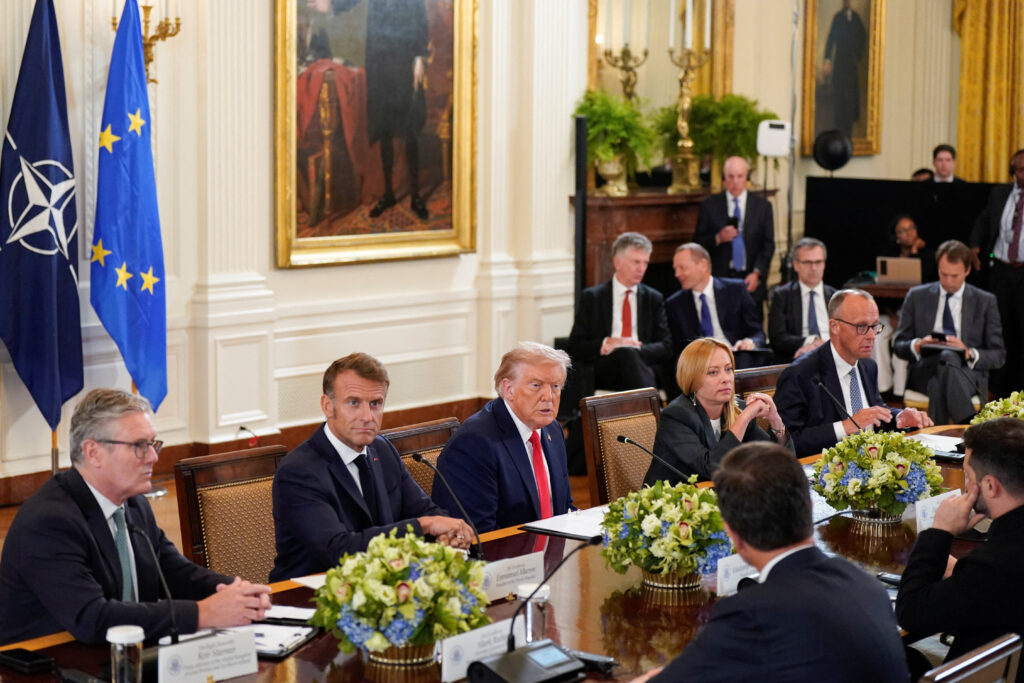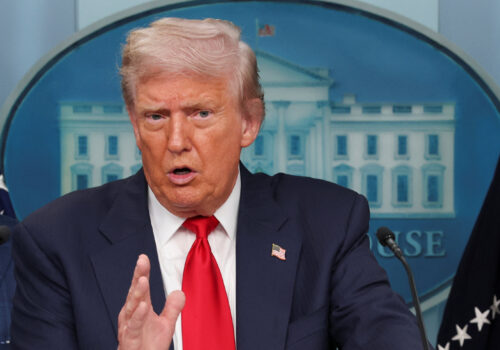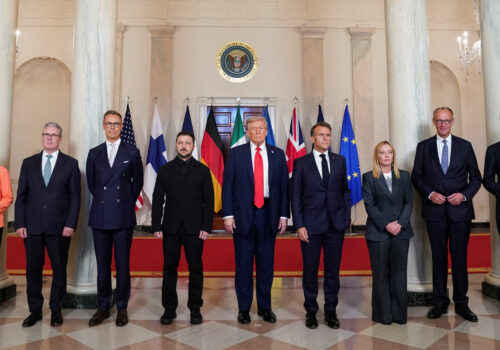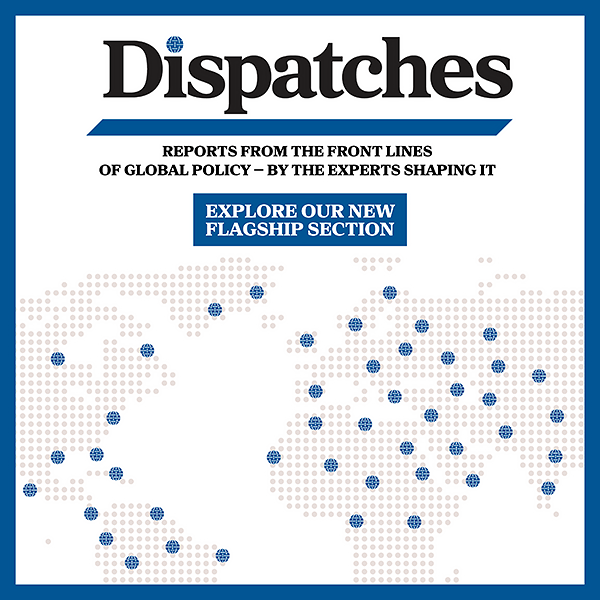Monday was undeniably a good day for Team Europe. The White House meeting between US President Donald Trump, Ukrainian President Volodymyr Zelenskyy, and seven European leaders went just about as well as it could have. A sustained charm offensive, diligent messaging, and strong rhetoric seem to have reinvigorated transatlantic unity in support of Ukraine following a disheartening summit in Alaska between Trump and Russian President Vladimir Putin.
Now, the job will only get tougher. Europe’s leaders must be prepared to press their newfound transatlantic alignment, rebut renewed Russian overtures to Trump, and articulate the necessary answers to the hard questions of guaranteeing Ukraine’s security. None of that will be easy.
Europe has done a laudable job to shape fast-moving developments on Ukraine, especially in the face of worrisome signs. The news of Friday’s meeting between Trump and Putin was met with consternation in Europe, even if leaders put on brave faces publicly to welcome the summit. The meeting had questionable pretexts and would only reward Putin. Worse, as several commentators noted, it carried the stench of Munich and Yalta—negotiations on European security of generations past that, in the former, rewarded genocidal aggression and, in the latter, subjected millions to autocratic rule without their say.
The results from the Alaska summit didn’t give much room for optimism either. Indeed, following his meeting with Putin, Trump walked back the need for a cease-fire as a precondition for negotiations. He also embraced the idea of Ukraine ceding unoccupied land to the Russians. European leaders thought they had talked Trump out of each of these moves before the Alaska meeting.
The picture of Trump and Zelenskyy flanked by European friends as Trump drives forward the peace process makes the US president look in command.
News of Zelenskyy’s short-notice trip to Washington carried nightmarish memories. With February’s disastrous Oval Office clash in mind, Europe set out to avert the worst-case scenario of a bad deal being imposed on Kyiv by Moscow and Washington. Joining Zelenskyy was an A-list delegation from Europe: German Chancellor Friedrich Merz, Italian Prime Minister Giorgia Meloni, British Prime Minister Keir Starmer, French President Emmanuel Macron, Finnish President Alexander Stubb, European Commission President Ursula von der Leyen, and NATO Secretary General Mark Rutte.
The idea to send backup was a creative, and ultimately successful, one. It strengthened Zelenskyy’s stature vis-à-vis Trump and painted a picture of transatlantic unity. Measured against Europe’s worst fears, Monday’s mad dash to Washington was a success of European diplomacy and unity. The Europeans visibly impressed Trump with their short-notice visit and some old-world flattery for his role as a peacemaker. Team Europe also came with a carefully prepared choreography to impress on Trump Ukraine’s and Europe’s vital interests in two priority areas—the need for an immediate cease-fire and a strong US role in meaningful security guarantees. Much of the meeting apparently focused on what “Article 5–like” guarantees Europe could provide Ukraine with support from the United States to avoid renewed Russian aggression after any “peace deal.” Reports of a European-funded $100 billion package of US defensive weapons for Ukraine would provide additional incentives for the United States to become engaged in a lasting deal. Allies avoided any big blowups about territorial concessions, and Trump did not press the issue.
Given how quickly European leaders mobilized to coordinate and define shared positions, this exercise showed Europe at its best: a bloc united to advance the cause of transatlantic support for Ukraine, willing to play its part.
But the details of these elements matter, and they remain scarce. Moreover, Trump’s European friends could not convince him of the need for a cease-fire for peace talks to make any meaningful progress. That should be the biggest warning sign to Europeans of just how short-lived the effect of their engagement efforts with Trump can be. In the run-up to the Alaska summit, European leaders had tried to convince Trump to press for a cease-fire specifically, as a minimum requirement for further negotiations, only to then watch the US president drop that position of transatlantic unity at the press conference with Putin.
At the White House on Monday, Europe met its strategic moment—for now. But Europe will need to sustain its efforts through the bilateral and trilateral talks promised for the coming weeks. A mercurial US leader receptive to flattery, and a Russian leader eager to regain the initiative, may make that challenging. Putin made clear in his press conference with Trump that he expects to negotiate with Washington and not let Europe and Kyiv “throw a wrench in the works” with “attempts to use some backroom dealings to conduct provocations to torpedo the nascent progress.” Europe should expect Putin to frame Ukraine and Europe as the unreasonable party in his future dealings with Trump. The question then arises: Can Europe pull off another White House visit if another Trump-Putin meeting changes the US president’s mind again?
As negotiations continue, Europe’s leaders should press two points.
First, Washington has greater leverage when it works with Europe. Leaders need to reiterate that point during every meeting. European states and the European Union are Ukraine’s largest supporters. The sanctions against Russia are hurting the Russian economy. European leaders should stress to Trump that together the United States and Europe have the cards to play against Putin. Optics matter here, too. The picture of Trump and Zelenskyy flanked by European friends as Trump drives forward the peace process makes the US president look in command. Compare that image with Putin, who has far fewer friends. Who is stronger?
Second, Europe is willing to spend what is needed to enforce a durable peace. Its leaders should press forward on defining what security guarantees for Ukraine look like via the “Coalition of the Willing,” recognizing how the dynamics of the discussions around guarantees have changed. So far, little progress has been made publicly on what such a coalition would do. The coalition members—in particular Germany, France, and the United Kingdom—need to get some clarity and then press the United States to support their plan. That should begin with public support for the positioning of European troops in unoccupied Ukraine to defend the country against future assault. The coalition should also press Trump to provide the necessary intelligence sharing, strategic enablers, and logistics—without US boots on the ground—and a US backstop to support such a force.
Trump has said he will work with Europe, and it will be up to Europeans to secure peace in Ukraine. Europe’s leaders must be up for the task.
Jörn Fleck is the senior director of the Atlantic Council’s Europe Center.
James Batchik is an associate director at the Atlantic Council’s Europe Center.
Further reading
Thu, Aug 14, 2025
When he meets Putin in Alaska, ‘heterodox’ Trump will face his biggest geopolitical test yet
Inflection Points By Frederick Kempe
The outcome of the meeting in Anchorage could have a long-lasting impact on geopolitics, Trump’s legacy, and his Nobel Peace Prize aspirations.
Mon, Aug 18, 2025
Was Trump’s summit with Zelenskyy and European leaders a turning point for Russia’s war in Ukraine?
Fast Thinking By
Our experts share their perspectives on what the White House summit means for efforts to end Russia’s war on Ukraine and provide security assurances for Kyiv.
Fri, Aug 8, 2025
Trump and Putin just announced a meeting in Alaska. What does that mean for the war in Ukraine?
Fast Thinking By
As attention turns to the tête-à-tête in the last frontier, we turn to our experts for their insights on what to expect.
Image: US President Donald Trump meets Ukrainian President Volodymyr Zelenskiy, German Chancellor Friedrich Merz, French President Emmanuel Macron, British Prime Minister Keir Starmer and Italian Prime Minister Giorgia Meloni amid negotiations to end the Russian war in Ukraine, at the White House in Washington, D.C., U.S., August 18, 2025. REUTERS/Alexander Drago




